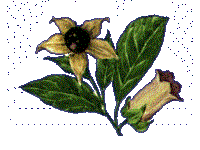Belladonna
By Sorrel
 "Throughout the accounts of the witchtrials of the 16th and 17th
centuries, one of the constant elements recorded was that of "flying
ointment". A number of recipes for this have survived showing that one
of the ingredients almost inevitably listed (along with aconite or
monkshood) was belladonna - deadly nightshade or Atropa belladonna as it
is also known. It is known that "flying ointment" was concocted from a
blend of several ingredients, each of which produced a particular
physiological effect.
"Throughout the accounts of the witchtrials of the 16th and 17th
centuries, one of the constant elements recorded was that of "flying
ointment". A number of recipes for this have survived showing that one
of the ingredients almost inevitably listed (along with aconite or
monkshood) was belladonna - deadly nightshade or Atropa belladonna as it
is also known. It is known that "flying ointment" was concocted from a
blend of several ingredients, each of which produced a particular
physiological effect. Its common name derives from its use in eye drops by women from the Roman period through to the Renaissance. It contains a muscle relaxant and acts on the eye muscles to relax the eye and therefore dilate the pupil - hence mimicking the effect of sexual interest or arousal and leading to its being known as "beautiful lady" - or belladonna. An alternative explanation of the name claims that it derives from Bellona, a goddess of war, and as a bringer of death such would not be inappropriate!
The plant is generally uncommon but grows in southern counties of England on limey soils in thickets and woodlands and sometimes naturalises in the vicinity of old buildings and quarries. It is a bushy perennial, growing up to 4' high, bearing dull purple bell-shaped flowers during June and July and purplish-black berries in the autumn; the latter are about the size of a small cherry. In folklore belladonna was the Devil's own plant and so keen was He on its cultivation that only at Beltane could He be diverted from its care and attention so that it may be gathered - hence one of the old folk names for this plant is the Devil's Cherry.
Atropa belladonna contains a number of alkaloids. The main one is a powerful and extremely dangerous psychedelic called hyoscamine. Added to this is scopolamine, which has been used in the interrogation of prisoners as it has the effect of causing profound confusion and disorientation, and atropine, which gives the plant its Latin name and is essentially a nerve poison. Atropine takes its name from Atropos - she of the Three Fates whose job it was to cut the thread of life. Again, not inappropriate!
A belladonna trip apparently starts out with pleasant hypnotic and "visionary" effects. Later effects during the trip, however, include blurred vision with unpleasant light-sensitivity, dry mouth and incoherent babbling. The general effect of this combination is one of extreme confusion, panic and anxiety. Permanent damage to the eyes may result, as may permanent brain damage. The effects of an overdose include vomiting and convulsions leading to collapse, heart failure and death. Other effects of the plant are to dry up mucous membranes and inhibit secretions (not an aphrodisiac, presumably!) and as a muscle relaxant.
By far the most poisonous part is the root with the leaves being less toxic and the berries less again. Mrs Grieve reports that an adult may eat a couple of berries without significant ill-effect, though one berry is enough to kill a child. When used in native areas the dosages range from 30 - 120mg for the root and from 30 - 200mg for the crushed and dried leaves thought it must be stressed that the upper ranges are not to be regarded as safe! Either way it may be eaten or smoked. Neither way is it recommended.
Belladonna is still used in modern medicine - it is found in some common sleeping pills for example, in Contact 400, where it acts todry up runny noses, in some asthma drugs and in surgery as a muscle relaxant before the anaesthetic is given. It is possible to overdose on a number of prescription asthma drugs and thus obtain a rather unpleasant belladonna trip courtesy of the NHS!"
- mere tvivlsom er måske nok samme tilhørers insisteren på, at det uforglemmelige barokke-visionære billede "Der vokser æbler på opvaskebørsten" i "digt" nr. 3 kan forklares med rygning af knuste grantæblekærner, endnu et populært 70'er-tripperi!?
Ingen kommentarer:
Send en kommentar